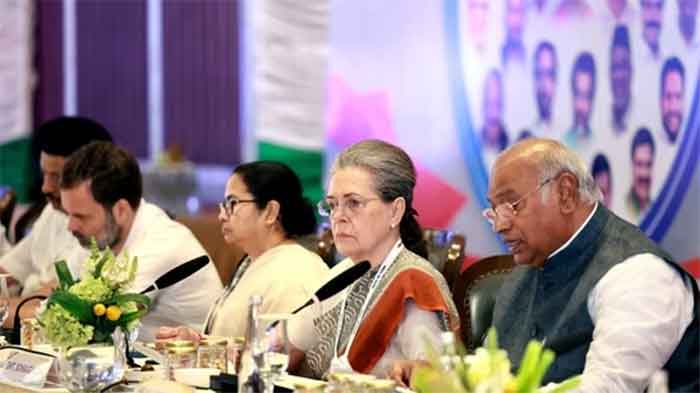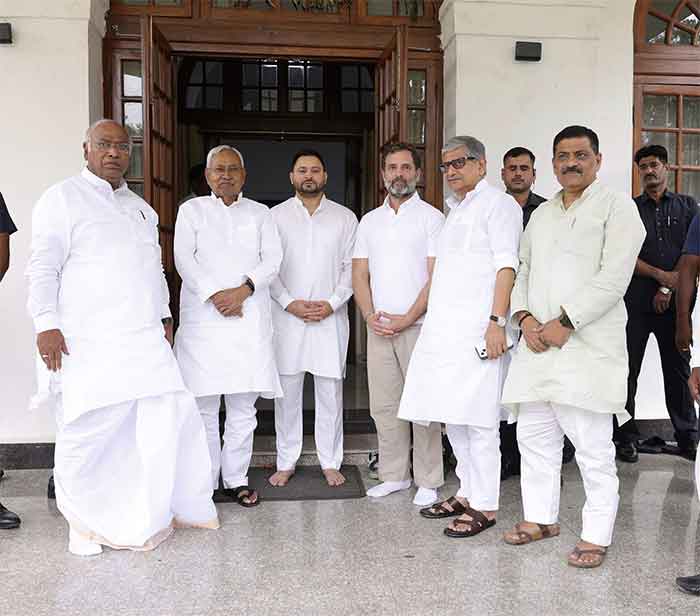
Display of unity by opposition parties against arrest of Aam Aadmi Party (AAP) leader, Delhi Chief Minister Arvind Kejriwal certainly appears to have pricked the time-tested political strategy repeatedly used by Bharatiya Janata Party (BJP), that of divide and “win.” Clearly, the presumption entertained by BJP rivals, particularly the Congress, led to this party’s dismal performance in 2014 as well as 2019 parliamentary polls. Congress appears to have learned the hard way that against political strategies exercised by BJP leaders and impact of so-called Modi-magic, even if on its own strength, the party succeeds in gaining media attention, attracting crowds and even in winning votes, each has limited significance if despite securing less than 40% votes, BJP candidates emerge as winners. BJP’s victory in preceding two elections does not simply rest on impact of hype raised about Modi-magic, Hindutva-wave and so forth but on failure of opposition parties to give it a strong fight. In other words, division within votes of more than 60%, apparently cast against BJP and/or definitely not in its favor, led it to emerge as the winner.
The political scenario would certainly have been different if Indian elections were primarily contested only between two key parties. The harsh political reality is that independent candidates tend to be deliberately fielded – apparently by being bribed; small parties spread out their candidates in the name of religion, caste and other factors; and other similar electoral moves lead to numerous candidates fight for one seat. As a result, division of votes plays a greater role in deciding the winner than that of his/her electoral appeal among majority of voters.
Against this backdrop, there is no denying, the recent few years appear to have send certain shock-waves to Modi-led government from several angles. Modi’s rivals have started being accorded greater importance than earlier. Of course, there is no denying that Modi appears to have gone overboard in apparently banking on the religious-card to appeal to Hindutva-votes in north as well as south. His use of Ayodhya-card as well as his attempt to attract the South Indian voter by religious moves in their region suggest this. Certainly, each move of his has earned him substantial publicity together with media coverage. In this age of communication boom, with numerous outlets of media competing with each other to stay ahead in according coverage to not just Modi but also his rivals, particularly if latter’s “news” appears to have appeal for public, it wouldn’t be wrong to presume that his “command” over media is now apparently devoid of the appeal it had for people around a decade ago. Yes, Modi remains in the forefront but his rivals have in recent past appear to have suddenly started receiving more attention than they did ahead of 2019 or of 2014 Lok Sabha elections.
In addition, there is no denying, politically, they are far more active now than they were earlier. Besides, compared to age of politicians in the former period, the present phase is witnessing younger politicians making their mark fairly strongly. As for instance, Arvind Kejriwal had not reached 50, when he took over as Delhi Chief Minister after spelling defeat of Congress leader Sheila Dixit’s government. Dixit was in her seventies. At present, both Congress leader Rahul Gandhi and Kejriwal are in their fifties. Besides, the neo-political energy displayed by Rahul through his yatras had not surfaced a decade ago. Of course, all leaders of INDIA bloc are not less than sixty. Nevertheless, there are also younger ones promoting parties founded by their seniors. These include RJD leader Tejashwi Yadav (Lalu Prasad’s son), Mulayam Singh’s son Akhilesh Yadav of SP, Supriya Sule, NCP leader Sharad Pawar’s daughter and so forth. Tejashwi is only 34, Akhilesh – 50 and Supriya- 54. From the Congress, Priyanka Gandhi Vadra (52) has always campaigned actively but now she has begun addressing from the stage at the national level. Of course, from BJP, UP Chief Minister Yogi Adiytanath is only 51, Union Home Minister Amit Shah-59, Smriti Irani-48 and so on. But where BJP is concerned, younger and/or older leaders’ political reach and appeal at present seems to be decided by that of Modi. For Modi-bhakts, against the name of Modi that of the party and/or other leaders appears to bears little or no relevance.
Against this backdrop, what can be said about electoral reach of INDIA-bloc? Perhaps, in lieu of the fact that BJP’s victory in 2014 and 2019 was primarily decided by less than 50% votes and as mentioned, the opposition parties failed to put a strong against it, in 2024– electoral strategies may display a different impact. Putting aside suspicions held regarding EVMs, possibility of electoral results being decided by percentage of voters, their age, background- including rural, urban, gender, religion, regional and other factors may be expected to play a key role. At the same time, the hard reality that political critics from urban areas, educated and upper classes don’t cast their votes as enthusiastically as do those from poorer backgrounds cannot be pushed aside. In addition, the fact that political appeal of most leaders of INDIA-bloc, including Kejriwal, is confined to their regional domains cannot be ignored. Kejriwal certainly enjoys popularity in Delhi but the same cannot be said about his appeal elsewhere. This may also be said about leaders from Kashmir, Maharashtra and other areas. Undeniably, Rahul’s yatras and political background have contributed to his enjoying greater national appeal than most other leaders of INDIA-bloc.
The preceding point apparently explains the frequency with which key BJP leaders don’t refrain from targeting Rahul as an important part of their electoral strategy. But their success will not be decided simply by whether the voters are convinced by their strategies or not. A lot may be dependent on degree of unity displayed by INDIA-bloc, last minute impact of any strategy of BJP (similar to Pulwama-attack) and of course the nature of voting pattern, from percentage of votes cast to their division. It is also possible, the younger lot of politicians in this fray may contribute immensely to actually attracting the new generation of voters, whose vote may play a lot more decisive role than is being speculated upon at present!
Nilofar Suhrawardy is a senior journalist and writer with specialization in communication studies and nuclear diplomacy. She has come out with several books. These include:– Modi’s Victory, A Lesson for the Congress…? (2019); Arab Spring, Not Just a Mirage! (2019), Image and Substance, Modi’s First Year in Office (2015) and Ayodhya Without the Communal Stamp, In the Name of Indian Secularism (2006).












































